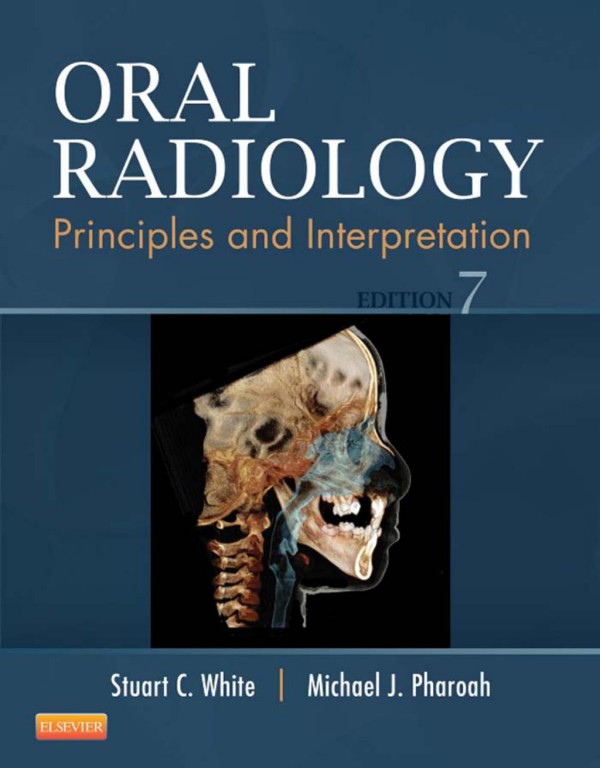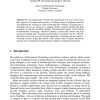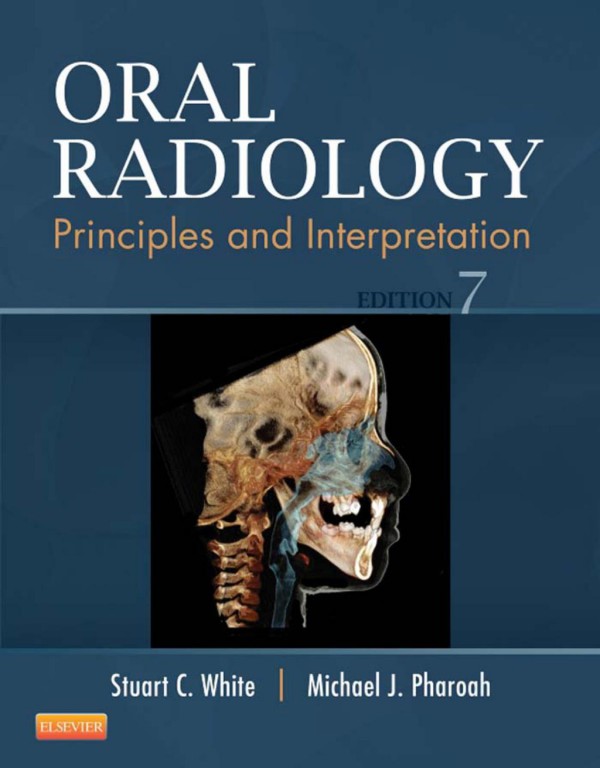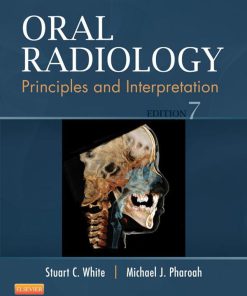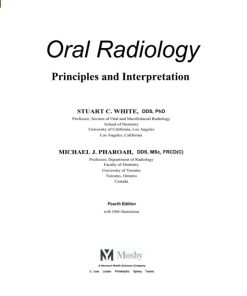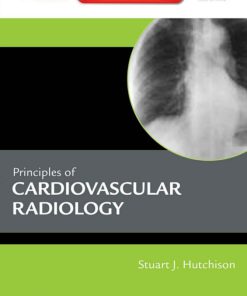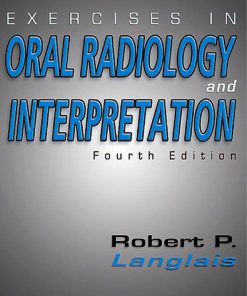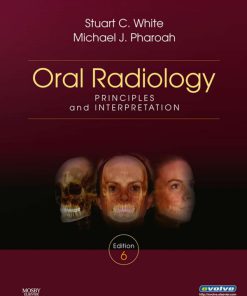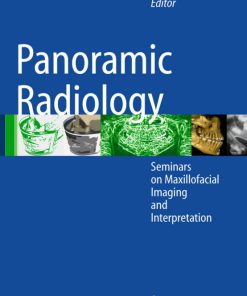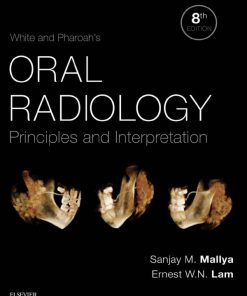Oral Radiology Principles and Interpretation 7th edition by Stuart White,Michael Pharoah 9780323171328 032317132X
$50.00 Original price was: $50.00.$25.00Current price is: $25.00.
Authors:Stuart C. White , Series:Dentistry [70] , Tags:Oral Radiology; Seventh Edition (2014) 697pp. 978-0-323-09633-1 , Author sort:White, Stuart C. , Ids:9780323096331 , Published:Published:Nov 2013 , Publisher:Elsevier Inc. , Comments:Comments:Oral Radiology, Seventh Edition (2014) 697pp. 978-0-323-09633-1
Oral Radiology Principles and Interpretation 7th edition by Stuart White,Michael Pharoah – Ebook PDF Instant Download/Delivery.9780323171328,032317132X
Full download Oral Radiology Principles and Interpretation 7th edition after payment
Product details:
ISBN 10:032317132X
ISBN 13:9780323171328
Author:Stuart White,Michael Pharoah
Oral Radiology Principles and Interpretation 7th Table of contents:
Part I Foundations
Chapter 1 Physics
Composition of Matter
Atomic Structure
Nucleus
TABLE 1-1 Fundamental Particles
TABLE 1-2 Force-Carrier Particles
FIGURE 1-1 Schematic view of a hydrogen atom showing a nucleus with one proton, composed of two up quarks (U) and one down quark (D) and two surrounding electrons (e−) within a 1s spherical orbital. Compared with the scale of the 1s orbital, the nucleus and electrons are much smaller than shown.
Electron Orbitals
FIGURE 1-2 Electron orbitals are clouds of varying density, probability plots of the location of the electron. The s-type electron orbital is spherical and centered around the nucleus. The p-type electron orbitals are bilobed and centered around the nucleus. Four of the five d-type electron orbitals are made up of four lobes, centered on the nucleus. The fifth d-type orbital is bilobed with an encircling ring (not shown).
Ionization
Nature of Radiation
Particulate Radiation
TABLE 1-3 Particulate Radiation
Electromagnetic Radiation
FIGURE 1-3 Electromagnetic spectrum showing the relationship between photon wavelength and energy and the physical properties of various portions of the spectrum. Photons with shorter wavelengths have higher energy. Photons used in dental radiography (blue) have energies of 10 to 120 keV. Magnetic resonance (MR) imaging uses radio waves (orange).
FIGURE 1-4 Electric and magnetic fields associated with electromagnetic radiation.
X-Ray Machine
X-Ray Tube
FIGURE 1-5 Tube head showing a recessed x-ray tube, components of the power supply, and oil that conducts heat away from the x-ray tube. Path of useful x-ray beam (blue) from the anode, through the glass wall of the x-ray tube, oil, and finally an aluminum filter. The beam size is restricted by the metal tube housing and collimator. Low-energy photons are preferentially removed by the filter.
FIGURE 1-6 X-ray tube with the major components labeled. The path of the electron beam is shown in yellow. X rays produced at the target travel in all directions. The useful x-ray beam is shown in blue.
Cathode
FIGURE 1-7 A, Dental stationary x-ray tube with cathode on left and copper anode on right. B, Focusing cup containing a filament (arrow) in the cathode. C, Copper anode with tungsten inset. Note the elongated actual focal spot area (arrow) on the tungsten target of the anode.
Anode
FIGURE 1-8 The angle of the target to the central ray of the x-ray beam has a strong influence on the apparent size of the focal spot. The projected effective focal spot (seen below the target) is much smaller than the actual focal spot size (projected to the left). This provides a beam that has a small effective focal spot size to produce images with high resolution, while allowing for heat generated at the anode to be dissipated over the larger area.
Power Supply
Tube Current
FIGURE 1-9 X-ray tube with a rotating anode allows heat at the focal spot to spread out over a large surface area (dark band). Current applied to the stator induces rapid rotation of the rotor and the anode. The path of the electron beam is shown in yellow, and the useful x-ray beam is shown in blue.
FIGURE 1-10 Schematic of dental x-ray machine circuitry and x-ray tube with the major components labeled. The operator selects the desired kVp from the autotransformer. The voltage is greatly increased by the high-voltage step-up transformer and applied to the x-ray tube. The kVp dial measures the voltage on the low-voltage side of the transformer but is scaled to display the corresponding voltage in the tube circuit. The timer closes the tube circuit for the desired exposure time interval. The mA dial measures the current flowing through the tube circuit. The filament circuit heats the cathode filament and is regulated by the mA selector.
Tube Voltage
FIGURE 1-11 A, A 60-cycle AC line voltage at autotransformer. B, Voltage at the anode varies from zero up to the kVp setting (70 kVp in this case). C, The intensity of radiation produced at the anode (blue) is strongly dependent on the anode voltage and is highest when the tube voltage is at its peak.
Timer
FIGURE 1-12 Bremsstrahlung radiation is produced by the direct hit of an electron on a nucleus in the target (A) or, much more frequently, by the passage of an electron near a nucleus, which results in electrons being deflected and decelerated (B). For the sake of clarity, this diagram and other similar figures in this chapter show only the 1s, 2s, or 3s orbitals.
Tube Rating and Duty Cycle
Production of X Rays
Bremsstrahlung Radiation
FIGURE 1-13 Spectrum of photons emitted from an x-ray machine operating at 70 kVp. The vast preponderance of radiation is bremsstrahlung (blue), with a minor addition of characteristic radiation.
FIGURE 1-14 Production of characteristic radiation. An incident electron (A) ejects an electron from an inner orbital creating a photoelectron, a recoil electron, and an electron vacancy (B). C, An electron from an outer orbital fills this vacancy, and a photon is emitted with energy equal to the difference in energy levels between the two orbitals. D, Electrons from various orbitals may be involved, giving rise to other characteristic photons. The energies of the photons released are characteristic of the target atom.
Characteristic Radiation
Factors Controlling the X-Ray Beam
Exposure Time (s)
FIGURE 1-15 Spectrum of photon energies generated in an x-ray machine showing that as exposure time increases (kVp and tube voltage held constant), so does the total number of photons. The mean energy and maximal energies of the beams are unchanged.
Tube Current (mA)
Tube Voltage Peak (kVp)
FIGURE 1-16 Spectrum of photon energies generated in an x-ray machine showing that as tube current (mA) increases (kVp and exposure time held constant), so does the total number of photons. The mean energy and maximal energies of the beams are unchanged.
Filtration
FIGURE 1-17 Spectrum of photon energies generated in an x-ray machine showing that as the kVp is increased (tube current and exposure time held constant), there is a corresponding increase in the mean energy of the beam, the total number of photons emitted, and the maximal energy of the photons. Compare with Figures 1-15 and 1-16.
FIGURE 1-18 Spectrum of filtered x-ray beam generated in an x-ray machine showing that an aluminum filter preferentially removes low-energy photons, reducing the beam intensity, while increasing the mean energy of the residual beam. Compare with Figures 1-15, 1-16, and 1-17.
FIGURE 1-19 Collimation of an x-ray beam (blue) is achieved by restricting its useful size. A, Circular collimator. B, Rectangular collimator restricts area of exposure to just larger than the detector size and thereby reduces unnecessary patient exposure.
Collimation
Inverse Square Law
FIGURE 1-20 Intensity of an x-ray beam is inversely proportional to the square of the distance between the source and the point of measure. When the distance from the source to a target is doubled, the intensity of the beam decreases to one quarter.
Interactions of X Rays with Matter
FIGURE 1-21 Photons in an x-ray beam interact with the object primarily by Compton scattering (57% of primary interactions), in which case the scattered photon may strike the film and degrade the radiographic image by causing fog. The next most frequent interaction is photoelectric absorption (27%), in which the photons cease to exist. A radiographic image is produced by photons passing through low atomic number structures (soft tissue) and preferentially undergoing photoelectric absorption by high atomic number structures (bone, teeth, and metallic restorations). Relatively few photons undergo coherent scattering (7%) within the object or pass through the object without interaction (9%) and expose the image receptor.
TABLE 1-4 Fate of 1 Million Incident Photons in Bitewing Projection
Coherent Scattering
Photoelectric Absorption
FIGURE 1-22 Coherent scattering results from the interaction of a low-energy incident photon with a whole atom, causing it to be momentarily excited. After this interaction, the atom quickly returns to the ground state and emits a scattered photon of the same energy but at a different angle from the path of the incident photon.
FIGURE 1-23 Photoelectric absorption. A, Photoelectric absorption occurs when an incident photon gives up all of its energy to an inner electron, which is ejected from the atom (a photoelectron). The incident electron ceases to exist at this point. B, The ionized atom now has an electron vacancy in the inner orbital. C, An electron from a higher energy level fills the vacancy and emits characteristic radiation. D, All orbitals are subsequently filled, completing the energy exchange.
Compton Scattering
FIGURE 1-24 Compton scattering occurs when an incident photon interacts with an outer electron, producing a scattered photon of lower energy than the incident photon and a recoil electron ejected from the target atom. The new scattered photon travels in a different direction from the incident photon.
Beam Attenuation
TABLE 1-5 Summary of Radiation Quantities and Units
FIGURE 1-25 Intensity of an energetically homogeneous x-ray beam declines exponentially as it travels through an absorber. In this instance, the HVL of the beam is 1.5 cm of absorber—that is, every 1.5 cm of the absorber reduces the intensity of the beam by half. The curve for a heterogeneous x-ray beam (e.g., a dental x-ray beam) does not drop quite as precipitously because of the preferential removal of low-energy photons by the absorber and the increased mean energy of the resulting beam.
Dosimetry
Exposure
Air Kerma
Absorbed Dose
Equivalent (Radiation-Weighted) Dose
Effective Dose
Radioactivity
Bibliography
Chapter 2 Biology
Radiation Chemistry
Direct Effect
Indirect Effects
FIGURE 2-1 Overview of events after exposure of humans to ionizing radiation. The initial ionization, direct and indirect effects, and initial molecular changes in organic molecules occur in less than a second. The enzymatic repair or development of further biochemical lesions occurs in minutes to hours. The deterministic and stochastic effects occur over a time scale of months to decades to generations.
DNA Changes
FIGURE 2-2 DNA damage cluster. A single photon may cause multiple ionizations in DNA, resulting in a cluster of double-strand breakage. In this instance, an incident photon causes ionization of a water molecule, and the recoil electron causes a cluster of damage to multiple sites in a DNA molecule. Such cluster damage is difficult to repair and is believed to be responsible for most radiation cell killing, carcinogenesis, and heritable effects.
Deterministic and Stochastic Effects
Deterministic Effects on Cells
Intracellular Structures
TABLE 2-1 Comparison of Deterministic and Stochastic Effects of Radiation
Nucleus
Chromosome Aberrations
FIGURE 2-3 Cell cycle. A proliferating cell moves in the cycle from mitosis phase when chromosomes are condensed and visible to gap 1 (G1) to the period of DNA synthesis (S) to gap 2 (G2) to the next mitosis. Cells are most radiosensitive in the G2 and mitosis phase, less sensitive in the G1 phase, and least sensitive during the latter part of the S phase.
FIGURE 2-4 Chromosome aberrations. A, Irradiation of a cell after DNA synthesis results in a single-arm (chromatid) aberration. B, Irradiation before DNA synthesis results in a double-arm (chromosome) aberration because the damage is replicated in the next S phase and becomes visible in the next mitosis phase.
Cell Replication
DNA Damage
TABLE 2-2 Relative Radiosensitivity of Various Cells
FIGURE 2-5 Chromosome aberrations. A, Ring formation plus acentric fragment. B, Dicentric formation. C, Translocation. D and E, Tetracentric exchange and chromatid exchange (arrows) taking place in Trandescantia, a New World perennial having a small number of large chromosomes.
Bystander Effect
Apoptosis
Recovery
Deterministic Effects on Tissues and Organs
Short-Term Effects
Long-Term Effects
Modifying Factors
Dose
Dose Rate
Oxygen
Box 2-1 Relative Radiosensitivity of Various Organs
Linear Energy Transfer
Radiotherapy in the Oral Cavity
Rationale
Effect on Oral Tissues
Oral Mucous Membrane
FIGURE 2-6 Oral complications. Typical time course of complications seen during and after a course of radiation therapy to the head and neck. Shaded area in first 6 weeks represents accumulated dose. Shading within bars indicates severity of complication. Note recovery of taste and healing of mucositis. Changes persisting after 2 years pose lifelong risks.
FIGURE 2-7 Mucositis of hard and soft palate. This patient is at the end of a course of radiotherapy and demonstrates an inflammatory response in the oral mucosa and areas of white pseudomembrane, areas where the oral epithelium separated from the underlying connective tissue.
Taste Buds
Salivary Glands
Teeth
FIGURE 2-8 Radiation effects on human parotid salivary gland. A, Normal gland demonstrating mostly serous glandular cells (purple) with ducts and occasional adipocytes (clear). B, Gland 6 months after exposure to radiotherapy. Note the loss of acini and the presence of chronic inflammatory cells (dark). C, Gland 1 year after exposure to radiotherapy. Note the loss of acini, extensive fibrosis (pink), and persistent inflammatory cells (dark).
Radiation Caries
Bone
FIGURE 2-9 Dental abnormalities after radiotherapy in two patients. The first patient, a 9-year-old girl who received 35 Gy at age 4 years because of Hodgkin’s disease, had severe stunting of the incisor roots with premature closure of the apices at 8 years (A) and retarded development of the mandibular second premolar crowns with stunting of the mandibular incisor, canine, and premolar roots at 9 years (B). The second patient (C), a 10-year-old boy who received 41 Gy to the jaws at age 4 years, had severely stunted root development of all permanent teeth with a normal primary molar.
People also search for Oral Radiology Principles and Interpretation 7th :
freny oral radiology
oral radiology salary
white and farrow oral radiology pdf
oral radiology residency
textbook of oral medicine and oral radiology
You may also like…
eBook PDF
Principles of Cardiovascular Radiology 1st edition by Stuart Hutchison 9780323314442 0323314449
eBook PDF
White and Pharoah’s Oral Radiology 8th Edition by Sanjay Mallya,Ernest Lam 9780323543842 0323543847

